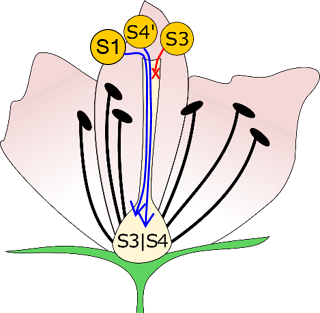Cherry Cross Compatibility
Many sweet cherry cultivars are not able to set a crop through self-pollination. These “self-incompatible” cultivars must be planted with a genetically different cherry cultivar (a pollinizer) that will provide the “compatible” pollen required for fruit set. Other cultivars are self-fertile and do not require a pollinizer.
Genetics
The ability of cherry pollen to grow down the flower style is controlled by the S locus. Each cultivar has two S-alleles and each pollen grain carries one of these. Flowers cannot be pollinated by pollen from any source that carries either of those two alleles, including its own. Due to inbreeding in the narrow genepool of North America, many pairs of cultivars share the same two S-alleles (same S-genotypes) and thus are cross-incompatible. The exception is the S4’ allele, which confers self-fertility. Effectively, S4’ acts as “stealth pollen” that can pollinate anything including flowers of the cultivar it came from.
Cross-incompatible cultivars with the same S-genotypes are placed in the same “Incompatibility Group” and cannot fertilize each others successfully. For more information on Incompatibility Groups, please see the functional genotype list for this DNA test.
Predictive Capacity
This DNA test robustly detects the common S-alleles of S1, S2, S3, S4, S4’, S5, S6, and S9. Most rare S-alleles are not detected and result in null alleles. For example, an S3 | S22 tree would only show the S3 allele with this test. To detect other alleles requires different DNA testing with allele-specific primers.
Although the S-genotypes are well known for most sweet cherry cultivars, every new individual created by breeding is a new unknown. S-genotypes of new cultivar releases should be determined prior to commercial planting. Before planning crosses, all prospective parents should be S-genotyped to avoid incompatible combinations. The DNA test can also identify self-fertile seedlings within breeding families.
When to Assay
Although the S-genotypes are well known for most sweet cherry cultivars, every new individual created by breeding is a new unknown. S-genotypes of new cultivar releases should be determined prior to commercial planting. Before planning crosses, all prospective parents should be S-genotyped to avoid incompatible combinations. The DNA test can also identify self-fertile seedlings within breeding families.
Allelic State of Selected Cultivars
Although dozens of S-alleles are known, some are very common The S4’ allele is increasing in frequency as breeders often strive to develop self-fertile cultivars.
| Genotype | Cultivar | Trait |
|---|---|---|
| S3|S4 | Bing | requires pollinizer |
| S4'|S9 | Glacier | self-fertile |
| S1|S4' | Lapins | self-fertile |
| S1|S4 | Rainier | requires pollinizer |
A table of haplotypes for important U.S. sweet cherry germplasm can be downloaded here.
Cross-compatible reaction: Only non-same and S4’ pollen can grow down the flower style for successful fertilization and eventually a fruit.

Allele Frequency for U.S. public cultivars: "Other" includes S2, S5, S6 and other rare alleles.

Technical Details:
Two simple PCR-based assays are multiplexed in this DNA test: Pav-S-universal that detects all of the common alleles in U.S. germplasm, and Pav-S4’-indel that distinguishes self-fertility-providing S4’ from the regular S4.

